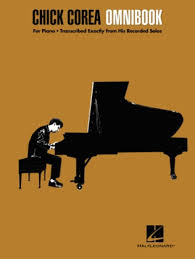Table of Contents
Come join us now, and enjoy playing your beloved music and browse through great scores of every level and styles!
Can’t find the songbook you’re looking for? Please, email us at: sheetmusiclibrarypdf@gmail.com We’d like to help you!
The Piano Improvisations of Chick Corea: A musical analysis (2/2)

An analysis of the Chick Corea Piano Improvisations leads to the consideration of several other issues. One of the most pressing of these is the question whether analytical methods usually associated with composed classical music are useful in the examination of improvisations employing the jazz style. This, in turn, raises more fundamental questions as to the differences between improvisation and composition, and between jazz and classical music.
Best Sheet Music download from our Library.
The methods used in this study— traditional harmonic, formal, and motivic analysis combined with melodic and harmonic reduction— do indeed prove to be valuable means of examining the music. As to the question of boundaries between improvisation and composition; jazz and classical music, however, inquiry into the Piano Improvisations serves only call the validity of making such distinctions at all into question. On the subject of placing music into jazz or classical categories, Corea has the following comments :
One can get into a great deal of controversy
trying to label things. As a matter of fact,
one of the artist’s functions is to create, and
not to be worried with what already established
mold one may fit into. . . . in that sense,
there should not even be a question. If there
is, then that raises the point of the purpose of
the question. Is it so that we will know where
to place this music in the curriculum?
Or is t so so that we may know how to review it,
in what section of the magazine, the classical or the
jazz section? Or is it so that we will know
what record label it should be sold under?

Steven Larson makes a similar point regarding the supposed differences between composed and improvised music. In answering the question of whether it is possible to apply analytic methods developed for the study of composed music (Schenkerian analysis) to improvisation, Larson writes, “This question suggests misconceptions about the content and origin of Schenker theories. . . . Compositions he [Schenker] analyzed may be considered records of successful improvisations.”
Please, subscribe to our Library.
If you are already a subscriber, please, check our NEW SCORES’ page every month for new sheet music. THANK YOU!
Larson goes on to demonstrate that many of the relationships found in composed music are also possible in improvisation.
The nature of Chick Corea’s Piano Improvisations demonstrates that the jazz and classical styles have much in common and can be blended to the point that the resulting music cannot be placed into either category. The present study also adds to evidence given in Larson’s dissertation, that improvisation and composition are closely related, and that many qualities associated with composition can be produced in improvised music.
The harmonic language in the Piano Improvisations is a combination of common practice harmony, jazz harmony, and more modern effects such as quartal/quintal sonorities and polychords. Traditional dominant-tonic relationships are common, but the chords are often altered, in a sense creating a highly contextualized treatment of consonance and dissonance. The clearest manifestation of this is the addition of extended notes, such as sevenths and ninths, even to the final tonic harmonies. Consider, for example, the final harmony of Noon Song, which reduces to the
following (m. 75):

The presence of a major seventh (C-sharp) and ninth (E) in no way diminishes the stability and finality of this sonority. This is due to the context that has been established throughout the piece: chords, tonic or otherwise, featuring only the root, third, and fifth of the triad are exceedingly rare.
In Ballad for Anna, a piece with a strong tonic of Eflat minor, the most common voicing of the tonic chord is as follows (e.g. m. 1):

Though this sonority is essentially a polychord (D-flat major triad over E-flat), the piece establishes a context whereby it serves as the tonic harmony. The nonfunctional harmonies that do occur are often circumscribed by traditional functionality. Consider the following passage from Noon Song (m. 22):

The series of quartal harmonies serve to prolong a functional harmony, in this case a rootless F-sharp dominant harmony, serving a clear role as V/vi. The quartal harmonies are a logical choice for moving between two versions of the F-sharp sonority that are themselves voiced mainly in fourths.
Harmonic motion in the Piano Improvisations, and indeed in much of jazz, often uses the same basic progressions driven by the same sort of voice leading as in common practice classical music. It is in the voicing of the individual chords, specifically in the notes added or omitted, that the main differences are found.
In terms of harmony and tonality jazz and classical styles, particularly as embodied in the Piano Improvisations, do not represent different languages so much as two dialects of the same language.
One of Corea’s most impressive accomplishments in the Piano Improvisations is the improvised creation of convincing forms. The common process from which the forms are generated is the use of variation technique. All the pieces use variation in some way, based on either harmonic or motivic material. This provides for a combination of variety and stability.
In his article on improvisation in the N e w Grove Dictionary of Jazz, Barry Kernfeld writes:
The essence of improvisation in jazz is the
delicate balance between spontaneous invention,
carrying with it both the danger of loss of
control and the opportunity for creativity of a
high order, and reference to the familiar,
without which, paradoxically, creativity cannot
be truly valued.
This balance of invention and reference to the familiar is a central feature of the Piano Improvisations. This is especially evident in the treatment of melodic and motivic materials. Most of the pieces have one or two motives from which a wide variety of melodic material is derived. This is an important factor in lending coherence to a potentially unwieldy genre. As Barry Kernfeld observes, “The fertility of invention of the greatest improvisers may be gauged by the variety of possibilities they find in a single theme.
In addition to motivic unity within the individual pieces, there are connections between the Piano Improvisations as a group. All the main motives involve stepwise descent through a third. Compare the main motives from each of the pieces: Noon Song, (x2)

Song for Sally

Ballad for Anna (a common version)

Song of the Wind (one of the most recognizable melodies)

Sometime Ago (y motive)

In the case of Ballad for Anna and Sometime Ago, the motives not only have the same intervallic content, but similar contour and rhythm as well. In addition to the main motives, much of the less structured melodic material throughout the Piano Improvisations also uses descent by step.
The motivic material often has an effect on other aspects of the music as well. In Noon Song, for example, the different versions of the main motive help to define the form. In Ballad for Anna, the harmonies often move by third, the interval spanned by the main motive. The melodic motion by second in Song of the Wind is reflected in the predominant bass notes of the major sections.
The high degree of motivic unity in the Piano Improvisations is difficult to explain without a truer understanding of the nature of improvisation. In Thinking in Jazz, an in-depth investigation into jazz improvisation using an ethnomusicological approach, Paul Berliner writes :
Jazz sheet music trancriptions download here.
The popular definitions of improvisation that
emphasize only its spontaneous, intuitive
nature— characterizing it as the ‘making of
something out of nothing’–are astonishingly
incomplete. This simplistic understanding of
improvisation belies the discipline and
experience on which improvisers depend, and it
obscures the actual practices and processes that
engage them. Improvisation depends, in fact, on
thinkers having absorbed a broad base of musical
knowledge, including myriad conventions that
contribute to formulating ideas logically,
cogently and expressively.
Improvisation as understood in this light has produced, in the Piano Improvisations, music that embodies blending of styles, a high degree of formal integrity, and, an artful combination of economy and invention.
Heinrich Schenker, yearning for a composer of new music who would carry on the traditions he revered, wrote, “this coming genius will be similar to the great masters of the past, but certainly just as different from them as all of them are different from each other. ” Hyperbole aside, the Chick Corea Piano Improvisations show that this is possible in ways that Schenker never would have imagined.”
Chick Corea: Vigilette | JAZZ NIGHT IN AMERICA
Browse in the Library:
Or browse in the categories menus & download the Library Catalog PDF:
